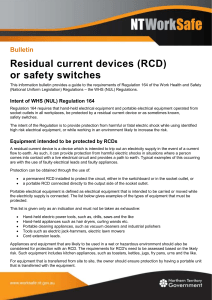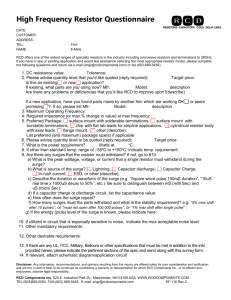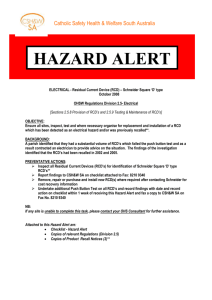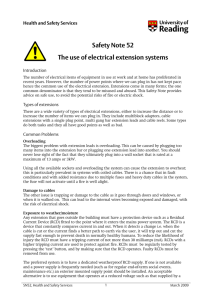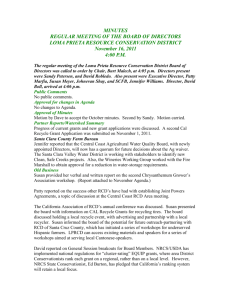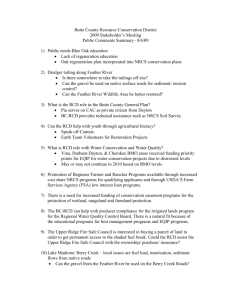Frequency of electrical testing checklist
advertisement
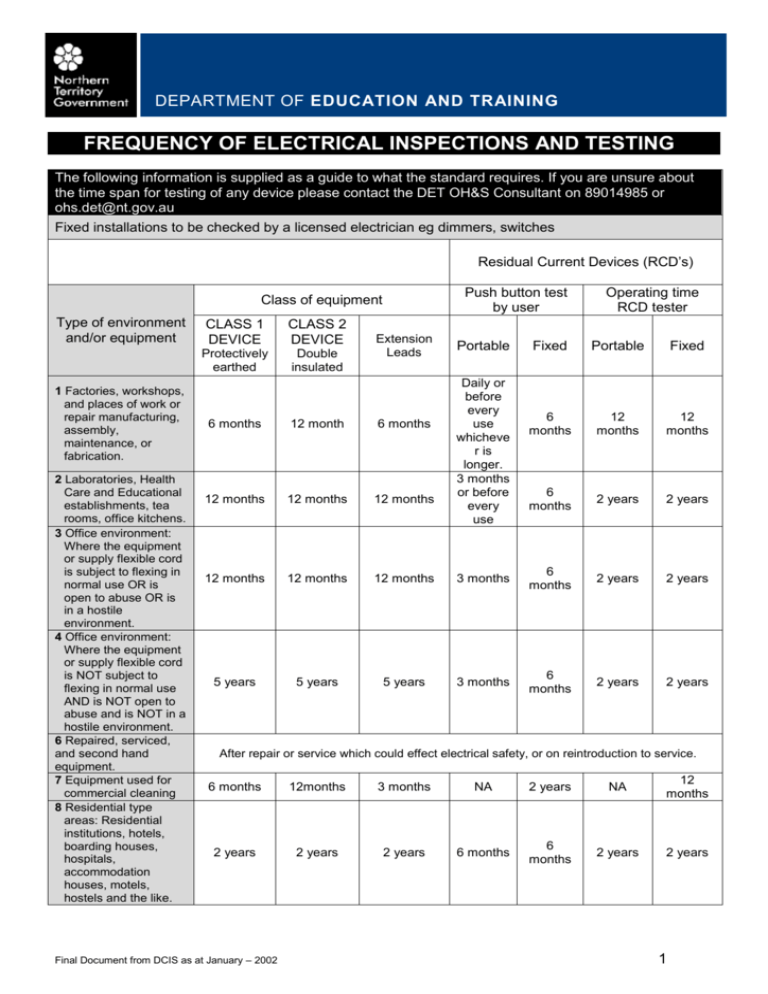
DEPARTMENT OF EMPLOYMENT, EDUCATION AND TRAINING DEPARTMENT OF EDUCATION AND TRAINING FREQUENCY OF ELECTRICAL INSPECTIONS AND TESTING The following information is supplied as a guide to what the standard requires. If you are unsure about the time span for testing of any device please contact the DET OH&S Consultant on 89014985 or ohs.det@nt.gov.au Fixed installations to be checked by a licensed electrician eg dimmers, switches Residual Current Devices (RCD’s) Push button test by user Class of equipment Type of environment and/or equipment 1 Factories, workshops, and places of work or repair manufacturing, assembly, maintenance, or fabrication. 2 Laboratories, Health Care and Educational establishments, tea rooms, office kitchens. 3 Office environment: Where the equipment or supply flexible cord is subject to flexing in normal use OR is open to abuse OR is in a hostile environment. 4 Office environment: Where the equipment or supply flexible cord is NOT subject to flexing in normal use AND is NOT open to abuse and is NOT in a hostile environment. 6 Repaired, serviced, and second hand equipment. 7 Equipment used for commercial cleaning 8 Residential type areas: Residential institutions, hotels, boarding houses, hospitals, accommodation houses, motels, hostels and the like. CLASS 1 DEVICE CLASS 2 DEVICE Protectively earthed Double insulated Extension Leads Portable Daily or before every use whicheve r is longer. 3 months or before every use Operating time RCD tester Fixed Portable Fixed 6 months 12 months 12 months 6 months 2 years 2 years 6 months 12 month 6 months 12 months 12 months 12 months 12 months 12 months 12 months 3 months 6 months 2 years 2 years 5 years 5 years 5 years 3 months 6 months 2 years 2 years After repair or service which could effect electrical safety, or on reintroduction to service. 6 months 12months 3 months NA 2 years NA 12 months 2 years 2 years 2 years 6 months 6 months 2 years 2 years Final Document from DCIS as at January – 2002 1 CLASS ONE EQUIPMENT – basic insulation and protectively earthed. Uses an earth wire to ensure fault protection. CLASS TWO EQUIPMENT – double insulated. Does not rely on basic insulation, extra insulation built in to appliance to ensure fault protection. THIS SYMBOL DENOTES A DOUBLE INSULATED APPLIANCE. WHO CAN CARRY OUT THE TESTING AND INSPECTIONS? Any person, who has been trained in the use of the testing devices, and in the process of testing and inspection, can carry out the testing and inspection of portable equipment and RCD’s. Contact the DCIS OHS branch on 89244500/89516580 to get information on training providers. The only time a qualified trades person is required to carry out the tests is when it is necessary to access the supply distribution board for measuring RCD tripping time and tripping current. There are two basic options here. The first is to spend the money on the testing devices, which is approximately $800, and train staff in the process. A training file will need to be established and maintained, and staff will need to be trained. In cases where the agency employs an Electrical trades person, then that person is already trained to carry out the inspections and tests. The second option is to get an Electrical Contractor to do the testing. However, if the agency has a large number of work places in isolated areas, then the contractor approach may become costly. WHAT TYPE OF TESTING DEVICE IS NEEDED? If a decision is made to carry out testing in house, there will be a need to purchase an insulation tester capable of a test voltage of 500 volts. The tester will need to be of a type with a continuity measurement function. This tester will cost approximately $350 including GST, and is available from major electrical wholesalers. This is a simple device to use and training in the use of this tester is very basic. There is also a need to purchase an RCD tester. An RCD tester will cost approximately $500 including GST, and is also available from major electrical wholesalers. This is also a simple device to use, but would need a little more training than for the continuity tester. FREQUENCY OF NON RECORDED INSPECTIONS PORTABLE EQUIPMENT - In addition to the recorded visual checks, all portable equipment should have a non-recorded visual check each time that it is used. SETTING UP YOUR WORKPLACE The objective of this booklet is to set out a simple process that allows for compliance with the requirements of Australian Standard 3760 - 2001. It is suggested that the system be set up by people in the workplace, and run by them also. This will ensure local knowledge of the current status of testing, and that funds are not being spent on contracting services that can be completed in house. STEP ONE - PURCHASE THE TAGS AND NUMBER EACH PIECE OF EQUIPMENT The tags are available from hardware stores, electrical contractors, etc. Ensure that tags are good quality, that they are ultra violet treated and have sufficient area to write the information that is needed. Having tags at the work place will also enable replacement of broken or worn tags, and to replace tags when equipment is put out of use, or a new item purchased. Final Document from DCIS as at January – 2002 2 STEP TWO - DRAW UP AN EQUIPMENT REGISTER AND CHECKLIST The equipment register is a simple list of the equipment in the work area that has an electrical lead attached to it, or is an RCD, and that is required to be tested as per this standard. Once the information is listed, note when the visual and electrical tests are required. This list will then act as a master document and can be used for auditing purposes. If there are any concerns as to the timing of these checks please contact the OH&S branch on 89244500/89516580. An example of this register is set out below. STEP THREE - TAG ALL EQUIPMENT Tag all the equipment such that the numbers line up according to what is listed on the checklist. Each piece of equipment should have a numbered tag placed on the lead, generally near the 3-pin plug. STEP FOUR - CARRY OUT THE CHECKS PORTABLE EQUIPMENT CHECKS A responsible and suitably trained person from within the work group can carry out the checks. As has been pointed out previously, this will ensure local knowledge of the current status of testing. There is also a cost benefit to your agency. For explanation purposes, the expanded questions from the checklist are set out below. This will indicate the actual check that is required for each point in the checklist. 1. 2. 3. 4. 5. 6. 7. Is the equipment free from obvious external damage? Is the switch working? Is there any obvious damage to the outside sheath of the lead? Is there any obvious damage to the power plug? Are any of the cores of the flexible lead exposed? Does the emergency stop work? Are the covers and guards in place? By grouping all the items requiring a 6-month check together, the 12-month checks together etc; there are less pieces of paper required for the recording system. The form is designed to have a number of items listed on each one, as long as all listed items have the same time span of checks. To add to that, the checklist is designed such that it can be used over a number of checks. PORTABLE AND FIXED RCD CHECKS The same system can be used for RCD checks. As can be seen by the table TWO above, there are different time spans allowed for different situations. There is a requirement to record the RCD’s that you have in the work place on a checklist, and test them regularly. The system of RCD checks requires placing the tester in a power point of the circuit that is required to be tested, initiating the test button, ensuring the circuit is tripped, and recording the trip time. An RCD is designed to break the circuit, or trip, each time there is a fault, and thus protect the user from electrical shock. Under fault conditions the RCD is required to trip the circuit within a specified time range. The trip time is measured in milliseconds. The test of each RCD that is required under this standard involves measuring and recording the trip time. Final Document from DCIS as at January – 2002 3 SUMMARY COMMENTS The objective of this booklet is to give some general information, and allow compliance with the basic intent of the Australian Standard. There are two choices in complying with this standard. One is to do the testing in house, and the other is to have a contractor do the testing. The advantages of in house testing are that staff has the opportunity to gain new skills, and that a reduction in the cost of compliance with this standard may be achieved. The objective is to keep the process simple, and ensure a minimum of paper work. The paper work is important. Under regulations attached to the Work Health act, and as a requirement of this standard, agencies are required to record all risk reduction measures. The inspection checklist combines a number of checks, and allows for the inclusion of a number of pieces of equipment. Ticking the correct box allows for changes to the time span for testing. This booklet is not meant to answer all the questions for all types of situations, although it should answer most. It is most important that if there are any questions regarding this matter that contact is made with the OHS branch in Darwin/Alice Springs on 89244500/89516580. FURTHER INFORMATION ON INSULATION TESTING (Australian Standard 3760 – 2001) TESTING OF EARTHING CONTINUITY Al GENERAL - The test of earthing continuity resistance shall be conducted during in-service testing of all Class I equipment. The testing shall be in conjunction with general inspections, including flexing and straining at points of entry and clamping points. A2 INSTRUMENTATION – An equipment tester, or continuity tester, of accuracy Class 5 or better. NOTE: Class 5 denotes an accuracy of 5% full-scale deflection. A3 TEST CONDITIONS - The resistance between any exposed metal parts, shall be measured, including rotating metal parts and the earth pin of the plug or to the supply earth. The resistance shall not exceed 1 OHM. For cord extension sets, portable outlet devices, and portable RCD’s, the resistance between the earthing connections of the plug and sockets shall be measured. The resistance shall not exceed 1 OHM. Figure AI shows one method of testing resistance. For the purpose of this Appendix, small, exposed metal parts such as nameplates, screws or rivets which are fixed or attached to non-conductive material in such a manner that they cannot become live, even in the event of a failure of internal insulation, are not required to be tested. Final Document from DCIS as at January – 2002 4 INSULATION RESISTANCE TESTING B1 – GENERAL Insulation resistance shall be measured during in-service testing of all equipment, cord extension sets, portable outlet devices, and portable RCD’s. B2 – INSTRUMENTATION AND METHOD An insulation resistance meter is required with the following characteristics: A measuring circuit isolated from earth, a nominal measuring voltage of 500 V D.C. and accuracy Class 5 or better. NOTE: Class 5 denotes an accuracy of 5%. B3 - TEST CONDITIONS B3.1 Metal parts that are normally earthed Insulation resistance is measured between live supply conductors and exposed metal parts, with the main switch/selector on the equipment in the 'ON' position. The resistance shall be not less than 1 MegOhm. NOTES: Figure B2 shows testing of insulation resistance of exposed metal parts. All conductors, except earthing conductors, are live conductors. For the purpose of this Appendix, small exposed metal parts such as nameplates, screws or rivets which are fixed or attached to non-conductive material in such a manner that they cannot become live, even in the event of a failure of internal insulation, are not required to be tested. B3.2 Class 2 equipment – Live parts to external metal parts (not earthed) Insulation resistance is measured between live supply conductors and external parts, with the main switch/selector on the equipment in the ON position. The resistance should not be less than 1 MegOhm. NOTE: Figure B2 shows testing of insulation resistance of external metal parts. B3.3 Conductors in flexible cords For cord extension sets, portable outlet devices and portable RCDs, the insulation resistance shall be measured between live supply conductors and the earthing conductor, with the mains switch/selector for the equipment in the 'ON' position. The resistance shall be not less than 1 MegOhm. Final Document from DCIS as at January – 2002 5 NOTE: Figure B3 shows testing of an EPOD. Final Document from DCIS as at January – 2002 6 TABLE 1 MAXIMUM TRIPPING TIMES RCD type A.C. RMS test current in Maximum tripping time in Milliamps Milliseconds Type 1 10 40 Type 2 30 300 TEST FOR OPERATION OF PORTABLE RESIDUAL CURRENT DEVICES (RCD’s) Dl GENERAL - Portable RCD’s shall be checked during in-service testing at intervals described in Table 1 for maximum tripping time. D2 INSTRUMENTATION - An RCD tester to apply the rated tripping current plus or minus 5%and measures time plus or minus 2.5%. D3 TEST CONDITIONS - A current equal to the rated tripping current shall be suddenly applied between active and the protective earth, and the operating time measured. NOTES ON OPERATING TIMES OF RESIDUAL CURRENT DEVICES 1. Tests are applied by the instrument test button (suddenly applied). In case of doubt, the number of test operations, up to 5, may be applied. 2. Some RCD’s may have a different result (up to 10 milliseconds) depending on the point on wave of the test current. In case of doubt operating time at both 0 degrees and 180 degrees should be tested. 3. Load leakage and stored energy can effect the result and increase the trip time indication. In case of doubt all load on the circuit should be disconnected. 4. A 240V instrument used on 230V may give a low-test current and a corresponding longer time. Ensure the correct rating and tolerance of the test instrument. 5. REFERS TO TESTING OF 3 PHASE UNITS. DO NOT UNDER ANY CIRCUMSTANCES TEST A 3 PHASE UNIT. Final Document from DCIS as at January – 2002 7 DEPARTMENT OF EDUCATION AND TRAINING EQUIPMENT CHECKLIST - VISUAL CHECKS AND ELECTRICAL TESTING Use a (X) to indicate a problem, “tick” for OK, use a (N) for not applicable. If there is a problem of some kind, note it in the comments. When the problem is fixed, make sure that the comments show this also. Checklist for equipment requiring the following check: (tick which one is appropriate) 3 mth 6 mth 1 yr 2 yr 5 yr Final Document from DCIS as at January – 2002 Date of Check Date of Check Date of Check Date of Check Emergency Stop Covers and Guards Cores Exposed Plug Damage Sheath Damage Switch Working External Damage Equipment No. EQUIPMENT TYPE: ……………………………………………… COMMENTS. (Including trip times for RCD’s) 8 WORK HEALTH BULLETIN 05.01.03 – (unformatted) Electrical, General safety requirements Electrical Safety should be managed with the same systematic approach as all other Occupational Health and Safety issues in the workplace. This approach requires the identification, assessment and control of risks associated with electrical equipment be it fixed, portable or temporary. LEGISLATION Regulations 62, 63, 64 and 65 of the Work Health (Occupational Health and Safety) Regulations outline the requirements in regard to electrical equipment and work practices. Regulation 62 requires all electrical installations, materials, equipment and apparatus at a work place to comply with AS: 3000 and AS: 3100. Please note that AS3000 is replaced with AS/NZS 3000:2000 which is in full effect from 15 March 2000. WHO IS RESPONSIBLE Every employer has a duty of care to ensure that their employees are safe from injury and risks to health while they are at work. For all electrical equipment and fixed wiring the employer must undertake hazard identification and risk assessment of these situations to eliminate risk of electrical hazards. IDENTIFY THE HAZARD All hazards associated with electrical equipment must be identified. This approach should be performed in consultation with the employer and workers. ASSESS THE RISK Risk is the likelihood that someone will be hurt, how they could be hurt, how much severity), for how long and how often a person is exposed to the hazard. What could be the severity of the injury? In the case of electrical hazards, death is frequently the result. CONTROL THE RISK Decide how the hazards/risks are going to be controlled. If elimination of the hazard is not possible, other controls should be implemented to reduce potential risks. These controls may include the use of residual current devices (RCD’s) – safety switches, regular monitoring, record keeping and the testing of electrical equipment and fixed wiring, safe systems of work and personal protective equipment. WHEN SHOULD AN RCD BE USED? Where an electrical hazard exists in new or modified fixed wiring installations (other than lighting circuits) and the risk assessment identifies that the hazard can be controlled by the installation of an RCD, an RCD must be fitted. Where electrical hazards are identified for existing wiring installations, a decision on the use of a non portable RCD is based on the practicality of the situation. Not all electrical equipment requires RCD protection. In some situations, equipment such as extension leads and desktop computers do not present a risk to their operations due to: • The permanent nature of their location. • How the equipment is used. • The workplace/environment conditions in which the equipment is used. Such equipment must however be periodically inspected and tested in accordance with the standard. Your risk assessment should be used to determine the need for RCD protection. Generally identifiable risks which do require RCD protection include: • Hand held electrical equipment, • Electrical equipment moved from place to place, • Electrical equipment where damage to the electrical supply cord could occur, • Electrical equipment that is used in an environment where damage to the appliance or to the electricity supply to that appliance could occur, such as wet and dusty conditions. WHEN SHOULD ELECTRICAL EQUIPMENT BE INSPECTED, TESTED AND TAGGED? All electrical equipment other than equipment situated in permanent locations or designed for extra low voltage, must be inspected, electrically tested and tagged in accordance with Final Document from DCIS as at January – 2002 9 Australian Standard AS3760: In-service safety inspection and testing of electrical equipment. This includes new equipment prior to being used. A visual inspection should be carried out each time electrical equipment is used to identify damaged leads, plugs etc. FLEXIBLE CORDS Flexible cords must be maintained in good condition and should be of a heavy duty type, and flexible cord conductors should have a minimum cross sectional area of 1.0 mm. For information on the maximum length of any flexible cords, refer to Work Health Information Bulletin No. WH 05.02.01 entitled ‘Electrical Safety Requirements for Construction Work’. Protection of flexible cords Flexible cords should be located in a position where they are not subject to mechanical or any other damage. Frequency of testing Generally the frequency of testing should be determined by the type of use and the environment in which the equipment is used. The Standard identifies the maximum time between tests. On construction sites, the maximum interval is 3 months due to the conditions in which electrical equipment is used. In a workshop environment this may be increased to 12 months, again depending on your risk assessment. Remember though that in some cases e.g. wet areas this would be less than 12 months. Competency required to test electrical equipment The inspection, testing and tagging can be conducted by a person the employer has assessed as competent having the necessary skill, training or experience to conduct the tests, the competency table below identifies the level of competency required to perform certain tasks. When electrical equipment is being hired out, inspection and testing must be carried out before each hire. Task Current Competency Level Required Routine inspection of electrical equipment – checking for external damage, frayed or damaged cords etc. Person who is familiar with the equipment, this could be the user of the equipment. Protective earth testing of equipment Person who is trained in the use of earth testing meters such as a continuity meter or ohmmeter. Insulation resistance testing of equipment or isolation transformers Person who has been trained in the use of insulation resistance testing meters, such as an insulation resistance meter or appliance tester. Push button test of portable RCD’s - Person who is using the RCD and has been instructed how to use the built in test button. Performance test of portable RCD’s – measure the tripping time and tripping current - Person who is trained in the use of an RCD tester. This training could be by in-house personnel, qualified electrician, and trade school or by the supplier of the RCD tester. Push button test on non-portable RCD’s - Person who is using the RCD and has been instructed how to use the built in test button. Performance test of non-portable RCD’s – to measure tripping time and tripping current - Licensed electrician is required if it will be necessary to access the supply distribution board. WHEN SHOULD RCD’s BE TESTED? Non-portable and portable RCD’s in permanent positions need to be push button tested at least once a year to ensure that the tripping mechanism has not failed. Portable RCD’s that are moved from place to place, need to be push button tested each day prior to their Final Document from DCIS as at January – 2002 10 use. It is also necessary to test the performance of the RCD. The test schedule for non-portable and portable RCD’s in permanent positions is every three years, in accordance with the test procedure in AS 3760. For portable RCD’s, the test schedule is every three months for construction and demolition sites, 12 months for industrial, two years for commercial and office environments and before each hire of hire equipment. For further clarification on specific workplaces refer to AS 3760. SHOULD THE RESULTS OF TESTING BE RETAINED? Regulation 65 requires records to be kept of all tests. This information is useful to program future testing and tagging and will provide an inventory of electrical equipment. New electrical equipment into the workplace should also be added to this inventory. WORKING WITH ELECTRICAL HAZARDS. A risk assessment must be conducted when any person is required to work near exposed electrical cables or live electrical equipment. In these situations control strategies may include the disconnection of the electrical supply, installation of barriers, the development of safe systems of work and /or the use of appropriately skilled staff. Other bulletins in this series include: • No. WH 05.01.01 Residual Current Devices • No. WH 05.01.02 Working Close to Overhead Power lines • No. WH 05.02.01 Electrical Safety Requirements for Construction Work • No. WH 05.02.02 Safety Inspection and Testing of Electrical Equipment on Construction Sites WORK HEALTH BULLETIN 05.01.01 – (unformatted) Electrical - Residual Current Devices (RCD) or safety switches This bulletin provides a guide to the requirements of Regulation 65 of the Work Health Occupational Health and Safety) Regulations. INTENT OF THE REGULATION Regulation 65 requires that hand-held electrical equipment and portable electrical equipment operated from socket outlets be protected by a residual current device or as sometimes known, safety switches. The intent of the regulation is to provide protection from harmful or fatal electric shock while using identified high-risk electrical equipment, or while working in an environment likely to increase the risk. EQUIPMENT INTENDED TO BE PROTECTED BY RCD’s A residual current device is a device that is intended to trip out an electricity supply in the event of a current flow to earth. As such, it will provide protection from harmful electric shocks in situations where a person comes into contact with a live electrical circuit and provides a path to earth. Typical examples of this occurring are with the use of faulty electrical leads and faulty appliances. Protection can be obtained through the use of: • a permanent RCD installed to protect the circuit, either in the switchboard or in the socket outlet, or • a portable RCD connected directly to the output side of the socket outlet. Portable electrical equipment is defined as electrical equipment that is intended to be carried or moved while the electricity supply is connected. The list below gives examples of the types of equipment that must be protected. This list is given only as an indication and must not be taken as exhaustive. • Hand-held electric power tools, such as, drills, saws and the like. • Hand-held appliances such as hair dryers, curling wands, etc. • Portable cleaning appliances, such as vacuum cleaners and industrial polishers. • Tools such as electric jackhammers, electric lawn mowers. • Cord extension leads. Appliances and equipment that are likely to be used in a wet or hazardous environment should also be considered for protection with an RCD. The requirements for RCD's need to be assessed based on the likely risk. Such equipment includes kitchen appliances, such as toasters, kettles, jugs, fry pans, urns Final Document from DCIS as at January – 2002 11 and the like. For equipment that is transferred from site to site, the owner should ensure protection by having a portable unit that is transferred with the equipment. EQUIPMENT NOT INTENDED TO BE PROTECTED BY RCD’s Some types of equipment are not intended to be covered by RCD's. These are equipment which present a very low risk of electric shock and which remain plugged in to the same socket for extensive periods (weeks to years) and are not moved or carried while they are operated. Some of these include • Desk top computers, computer printers and monitors, desktop clocks. • Photocopiers. • Refrigerators. • Electro medical equipment where it could be detrimental to the health of a patient if connected through an RCD. NEW BUILDINGS AND INSTALLATIONS Consideration should be given to installing permanent residual current devices into new workplaces, or when installing new electrical circuits. Design of the circuits before installation, based on likely end use will often make this the most cost-effective means of installing residual current device protection. NOTE: All new domestic dwellings are required to have socket outlets protected by RCD's under the SAA Wiring Rules (AS 3000) and Power and Water Authority legislation. These wiring rules have changed and the new wiring rules AS/NZS 3000:2000 must be followed as of 15 March 2000. Electrical Safety Bulletin 02.01.01 refers. TESTING OF RESIDUAL CURRENT DEVICES The regulations require that a residual current device installed at a workplace shall be kept in a safe working condition and tested on a regular basis by a competent person to ensure its continued effective operation. A record must be kept of these tests. Guidelines for testing of residual current devices is provided in Australian Standard 3760 - In service Safety Inspection and Testing of Electrical Equipment, which is an approved code of practice under the Work Health Act 1986. It is also good practice for people to regularly test the units using the test buttons on the devices. Guidance on this is usually provided with the device. Frequency of testing will depend on the environment in which the device and the equipment are being used, with more frequent testing required for harsher environments. For portable RCD’s the test button should be operated each time it is plugged into a socket outlet. Final Document from DCIS as at January – 2002 12

